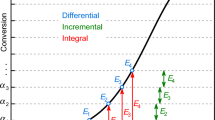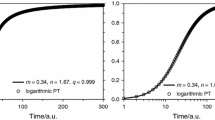Summary
A result obtained earlier implies that — if theEyring theory is correct — the energy of the transition state is less thanU+E a whereU is the sum of the internal energies of the chemical reactants andE a is the energy of activation. The energy of the transition state for the forward reaction is not equal to that of the inverse reaction; it varies linearly with the temperature.
Zusammenfassung
Aus einem früher erhaltenen Ergebnis folgt, daß — Richtigkeit derEyring-Theorie vorausgesetzt — die Energie des Übergangszustands geringer ist alsU+E a (U: Summe der inneren Energien der Reaktanden;E a: Aktivierungsenergie). Die Energie des Übergangszustands ist für Hin- und Rückreaktion unterschiedlich und hängt linear von der Temperatur ab.
Similar content being viewed by others
References
Stepanov IA (1993) J Therm Anal39: 1375
Stepanov IA (1994) Pozharovzryvobezopasnost1: 3
Glasstone S, Laidler K, Eyring H (1948) The Theory of Rate Processes. Nauka, Moscow (Russ transl)
Emanuel NM, Knorre DG (1984) A Course of Chemical Kinetics. Vysshaja Shkola, Moscow
Stepanov IA (1996) Monatsh Chem127: 1247
Author information
Authors and Affiliations
Rights and permissions
About this article
Cite this article
Stepanov, I.A. On the linearity of the energy of activation in theEyring theory of kinetics. Monatsh Chem 128, 991–994 (1997). https://doi.org/10.1007/BF00806965
Received:
Accepted:
Issue Date:
DOI: https://doi.org/10.1007/BF00806965




